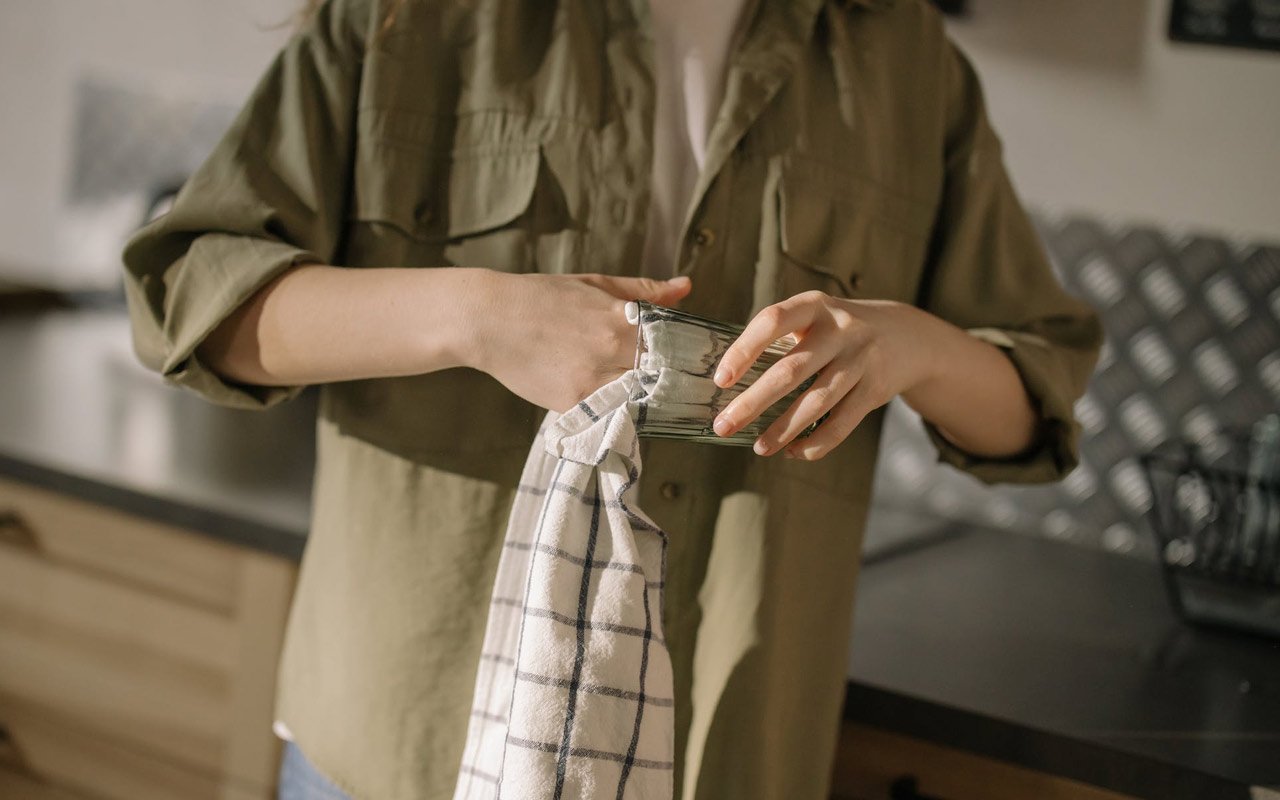When food handlers are studying for their Texas food handlers certificate, one of the most frequently asked questions is “What cannot be used to dry utensils?”
It’s strange, isn’t it? It’s not difficult to wash and dry dishes at home, but you need to know the proper washing and drying techniques. To keep your customers safe, you shouldn’t dry your utensils the same way you would at home.
You might be tempted to grab a towel and dry the dishes and utensils after you have finished washing them in your business. Then you can quickly use them for food service. It’s not the best way to go, however natural it may seem.
After cleaning your food and utensils, you can risk exposing them to bacteria and germs.
Table of Contents
What can’t be used to dry utensils?
Food handlers need to be aware of what can and cannot be used for drying utensils. Wiping dishes and utensils with towels or cloths after washing is a common practice. However, germs can be spread by wiping with towels and cloths.
A dishwasher is the best method to dry utensils. Dish dryers dry dishes quickly and kill bacteria. Some dishwashers also come with sanitizing functions.
You can dry dishes and utensils by air drying if you don’t have a dishwasher. Although drying your dishes by air may take longer, it is better than having to wash them with towels and reusable cloths.
You should also use appropriate air-drying materials. Materials that rapidly evaporate moisture are ideal. This is to keep mildew and bacteria from growing in your drying area.
Towel
While many people use towels to dry dishes, you might also use them. We say that the towel should not be used for drying dishes or utensils. It is hard to change this long-standing habit. For generations, dishes have been dried with towels.
Scientists question why people use towels to dry dishes. Towels can contain allergens, mites, and dust that can get into food, which can have adverse effects on your health.
Professor of microbiology at Arizona University, Dr. Charles P. Gerba also stated that towels should not be used to dry dishes or other kitchen utensils. Unsanitary napkins and towels were used to clean utensils.
According to Gerba, it is not a matter of cleanliness. Utensils such as these can contain allergens and mites that can cause health problems. Additionally, if the dinner plate is not clean, it can become infected by bacteria like E. coli and staphylococcus.
Stoppers for sinks
Sink stoppers are the next equipment that can’t be used to dry kitchen utensils. This is a tool that filters kitchen waste to ensure it doesn’t clog your drainpipe.
Sink stoppers, as we all know, are full of bacteria. This is because many types of dirty water such as dishwashing and other household cleaning products can pass through the holes.
There will be many types of bacteria, germs, and microorganisms that stick to the sink stoppers as water flows from them. Sink stoppers can be used to dry utensils.
You are concerned that microorganisms and germs could get onto your kitchen utensils and then make it difficult for you to eat.
Tea towels
You may also use tea towels to dry spoons, dishes, and other utensils. Tea towels are not the best material to dry utensils.
Tea towels are used to absorb water. However, you need to know how dirty it is, how long it has been used to absorb it, and how it can be used to dry your kitchen utensils.
It is not healthy, and it can harbor many types of bacteria and germs. Drying your equipment will make it more worthwhile.
A study on tea towels was done at Clemson University. It was discovered that between 94-96% and 94% of tea towels collected were contaminated by bacteria and other microorganisms.
Dishwashing sponges or pads
A dishwasher sponge is a great option, and you can even use it to dry your utensils.
This small cushion can also be a home for bacteria. Because it’s always moist, it can become a place for bacteria, fungi, and other organisms. Therefore it’s not possible to dry dishes with it.
You and your family may be at risk for skin conditions such as redness, inflammation, itching, and fungus if you dry the utensils with a dishwashing sponge.
According to Dr. Carl Conrad, he conducted research on napkins and found that the same thing happened to dishwashing sponges.
Research under Dr. Rina Marie Cicarello, an associate professor at the University of Georgia’s College of Veterinary Medicine, School of Public Health, has shown that sponges are used to dry utensils.
The sponge can be a breeding ground for bacteria like E-Coli and streptococcus, as well as Klebsiella pneumonia. They can affect our overall health.
Synthetic towels
Synthetic towels can also be used to dry dishes. They are able to remove the excess water quickly. We don’t realize that nylon synthetic fabrics can harbor bacteria due to their moist conditions.
It can also infect our plates, spoons, and other kitchen utensils with bacteria. This can affect our health.
Wool mop
Also, woolen and mops should not be used for drying dishes or other utensils. It can also retain moisture over time, which can lead to the growth of bacteria.
Use your hands only
You may have used your hands empty to dry your plates when you were done eating.
Our hands can also be containers and areas for bacteria. Although our hands are used for many purposes, we often forget that they can also be infected by bacteria and microorganisms.
Hands can only be dried when they are dry. You may not be able to dry dishes if your hands aren’t clean. Be careful about trivialities like this.
Drying containers
Because the material is made from open mesh, no water settles inside it and water can flow out easily, drying containers are a good choice for drying equipment.
You might be able to use it, but you need to be aware of how it is. If it’s damp, you should not use it. It’s a great place to grow bacteria, and it’s best not to let it get wet. You should use caution when drying your dishes.
Cloth napkins
Cloth napkins are not recommended for drying utensils. It all depends on the circumstances. Many people recommend cloth napkins for drying dishes. This material is easy to dry and has no moisture or residual water.
Its rugged and fibrous structure allows for airflow, which facilitates quick drying. This can dry dishes, spoons, and other items. It can dry dishes, spoons, etc. quickly and without moisture.
Rack for dish drying
Current practice is to use a dish rack both as a container or place to dry dishes. You should not use metal shelves or any other materials that could cause water to stay on the shelf. This can lead to bacteria growth.
A stainless rack may work well to keep water out of the dishes and allow for air circulation to dry them. It’s possible to dry dishes without contacting certain ingredients if it is like this.
The dishes that are just washed can dry in 30 minutes if you take advantage of the air circulation.
How do you dry your utensils?
You might use a towel at home. In the food industry, however, all dishes and utensils must be dried thoroughly.
After washing them, place them on a dish rack to dry naturally. This process can take longer than drying them by hand so make sure to have plenty of dishes on hand to serve your customers.
After your dishes and utensils have dried, you can place them on a flat surface. You should store cups, plates, and bowls upside-down.
How to Wash and Dry Food Industry Products?
You will discover that washing dishes and drying utensils are more complicated than it seems when you study for your Texas food handlers license. While it is not more difficult than at home, it does require precision to ensure your customers are safe and prevent cross-contamination.
Every year, food poisoning is a problem that affects millions of Americans. This can be prevented by changing your washing and drying techniques. The following steps will help you wash, rinse, and clean your dishes between uses.
Step 1: Get the dishes and sink ready
To make sure dishes can be washed in a safe environment, clean and sanitize your sink. Recycle any leftover food.
Step 2: Wash the dishes
Hot, soapy water should be used to fill the first sink of your establishment. Pay attention to the temperature of your water and whether there are any suds as you wash dishes. Start over if the water cools too quickly or the suds disappear.
Step 3: Rinse the dishes
Add hot, clean water to the second sink in your commercial kitchen. This sink can be used to rinse your dishes.
Step 4: Clean the dishes
A majority of commercial kitchens feature a three-sink bench. To clean your dishes, use the third sink. This can be done by using an approved sanitizer and allowing your dishes to soak for the recommended time.
Step 5: Dry the dishes with a fan
You’ve been wondering what you shouldn’t use for drying utensils. You now know. Air is the only thing you can use. To dry dishes and utensils, do not use towels or other fabrics. They can be dried on a rack that has been cleaned and disinfected until they are dry enough to store and use.
Clean Dishes and Utensils Safely
To keep guests safe, the hospitality industry must maintain a certain level of cleanliness. Even simple tasks like cleaning dishes or utensils may require a different practice than what you are used to.
This process is not difficult, even though it may seem complicated. These rules will not only help you be a safe food handler, but they can also ensure that you are in the best possible position to complete your online course and receive your certificate.
Frequently Asked Questions
Should You Air Dry or Towel Dry Your Dishes?
Commercial dishwashers use hotter water than home dishwashers, so people may be more at risk at home than at large institutions. It's better to dry dishes in the air than to use dish towels. Dish towels can harbor bacteria. It is used to wipe your hands, dry the counter, and then dry the dishes.
The best way to dry dishes is by drying them in the air. If you prefer to dry your dishes by hand, use a clean, unworn cloth.
What is used to dry dishes?
To dry dishes, wash them in hot, soapy waters. It's fine to dry dishes with a towel, as long as it is not stained. A towel has the advantage of drying dishes quickly and thoroughly, then allowing them to dry completely before putting them away.
Why don't you towel dry dishes that have been hand washed?
It's better to dry your dishes at home than to use a dishtowel, as dish towels can harbor bacteria. It is used to wipe your hands, dry the counter, and then dry the dishes.
Which is used in the kitchen to dry dishes and other surfaces?
A dishcloth or dishrag can be used in the kitchen to dry or clean dishes. Dishcloths are usually made from cotton or another cloth such as microfiber and measure between 11" and 13 inches in the square. Tea towels are dishcloths that are used to dry dishes.



